
The Araceae are a family of monocotyledonous flowering plants in which flowers are borne on a type of inflorescence called a spadix. The spadix is usually accompanied by, and sometimes partially enclosed in, a spathe or leaf-like bract. Also known as the arum family, members are often colloquially known as aroids. This family of 140 genera and about 3,750 known species is most diverse in the New World tropics, although also distributed in the Old World tropics and northern temperate regions.

Philodendron is a large genus of flowering plants in the family Araceae. As of September 2015, the World Checklist of Selected Plant Families accepted 489 species; other sources accept different numbers. Regardless of number of species, the genus is the second-largest member of the family Araceae, after genus Anthurium. Taxonomically, the genus Philodendron is still poorly known, with many undescribed species. Many are grown as ornamental and indoor plants. The name derives from the Greek words philo- or "love, affection" and dendron or "tree". The generic name, Philodendron, is often used as the English name, "philodendron".

Anthurium is a genus of about 1,000 species of flowering plants, the largest genus of the arum family, Araceae. General common names include anthurium, tailflower, flamingo flower, and laceleaf.
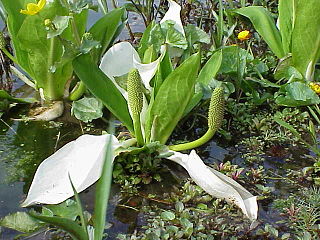
Lysichiton is a genus in the family Araceae. These plants are known commonly as skunk cabbage or less often as swamp lantern. The spelling Lysichitum is also found. The genus has two species, one found in north-east Asia, the other in north-west America.

Nephthytis is a genus of eight species of flowering plants in the family Araceae, native to tropical western Africa, with one species in Borneo.

Rhaphidophora is a genus in the family Araceae, occurring from tropical Africa eastwards through Malesia and Australasia to the Western Pacific. The genus consists of approximately 100 species.

Callopsis is a monotypic genus from the plant family Araceae and has only one species, Callopsis volkensii. This plant forms a creeping rhizome and has cordate-ovate leaves that are medium green and glaborous. The inflorescence is typical of the family Araceae, with a white spathe and yellow spadix. The spadix is shorter than the spathe and its male and female flowers are separated shortly.
Ambrosina is a genus in the family Araceae that consists of only one species, Ambrosina bassii, and the only genus in the tribe Ambrosineae. This species is the smallest aroid in the Mediterranean, growing only to 8 cm tall. It is usually found growing in woodlands on north faces of hillsides and in humus soil that is covering limestone. It is distributed in Sardinia, Corsica, Sicily, southern mainland Italy, Tunisia, and Algeria.

Aridarum is a genus of flowering plants in the family Araceae. All of the known species in this genus are rheophytic and are endemic to the Island of Borneo. The plant is aquatic and has willow-shaped leaves that are able to take strong currents without sustaining damage.

Bucephalandra is a genus of flowering plants in the family Araceae. There are 30 species of Bucephalandra which have been discovered in Borneo and have been formally described by S.Y. Wong and P.C. Boyce. Most of the species are found in Borneo. Bucephalandra are usually found growing as dense mats over stones or rocks in streams or rivers in moist tropical forest.

Aroideae is a subfamily of flowering plants in the family Araceae. It is the largest subfamily in Araceae and consists of about 72 different genera, and 2,300 species. Many Aroideae have spiny pollen grains without a sporopollenin outer exine layer and lacking an aperture.
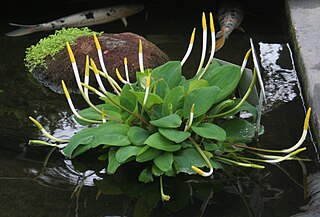
Orontium aquaticum, sometimes called golden-club, floating arum, never-wets or tawkin, is a species of flowering plants in the family Araceae. It is the single living species in the genus Orontium, which also contains several extinct species described from fossils. O. aquaticum is endemic to the eastern United States and is found growing in ponds, streams, and shallow lakes. It prefers an acidic environment. The leaves are pointed and oval with a water repellent surface. The inflorescence is most notable for having an extremely small almost indistinguishable sheath surrounding the spadix. Very early in the flowering this green sheath withers away leaving only the spadix.

Holochlamys is a monotypic genus of flowering plants in the family Araceae. Holochlamys beccarii is the only species in the genus Holochlamys. It is native to New Guinea and the Bismarck Archipelago and is found growing in mud near lowland streams or rocky streambeds at high elevations.
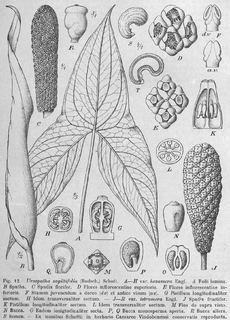
Urospatha is a genus of flowering plants in the family Araceae that consists of approximately 10 known species. They are found growing in South America and Central America in swamps, wet savannahs, and brackish water. The leaves of the species in this genus are upward pointing and sagittate (arrow-shaped). The inflorescences are quite unique; the spathe is mottled and elongated with a spiral twist at the end. The seeds are distributed by water and have a texture similar to cork that allows them to float. They also quickly germinate in water.

Anaphyllum is a genus of flowering plants in the family Araceae. It consists of two species. They are found in marshes, have leaves with some pinnation, and have a twisted spathe. The two species in this genus are similar in appearance to those in the genus Anaphyllopsis.
- Anaphyllum beddomeiEngl. - Tamil Nadu, Lakshadweep
- Anaphyllum wightiiSchott. - Kerala, Lakshadweep
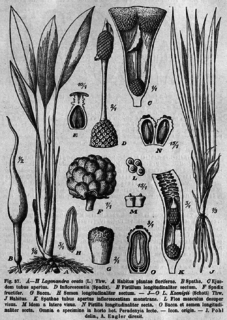
Lagenandra is a genus of flowering plants in the family Araceae. It is endemic to the Indian Subcontinent. The genus is similar to Cryptocoryne, but can be distinguished from it by its involute vernation. Cryptocoryne on the other hand exhibit convolute vernation.
Zomicarpella is a genus of flowering plants in the family Araceae. It is native to Colombia, Peru and Brazil. The leaves are hastate or sagittate. The chromosome number for Zomicarpella species is 2n=26. Additionally, the seeds have an endosperm.
- Zomicarpella amazonicaBogner - Amazonas State of northwestern Brazil
- Zomicarpella maculataN.E.Br. - Colombia, Peru
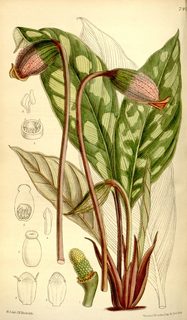
Piptospatha is a genus of flowering plants in the family Araceae. The genus is characteristic is rheophytic and has seeds that are dispersed by splashes of water hitting its cup-like spathes. It is native to Southeast Asia.
- Piptospatha burbidgei(N.E.Br.) M.Hotta - Sarawak, Sabah
- Piptospatha elongata(Engl.) N.E.Br. - Kalimantan Barat
- Piptospatha impolitaS.Y.Wong, P.C.Boyce & Bogner - Sarawak
- Piptospatha insignisN.E.Br. - Sarawak
- Piptospatha manduensisBogner & A.Hay - Kalimantan Timur
- Piptospatha marginata(Engl.) N.E.Br. - Sarawak
- Piptospatha perakensis(Engl.) Ridl. - southern Thailand, Peninsular Malaysia
- Piptospatha remiformisRidl. - Sarawak
- Piptospatha repensH.Okada & Tsukaya - Kalimantan Barat
- Piptospatha ridleyiN.E.Br. ex Hook.f. - Johor, Pahang, Selangor
- Piptospatha truncata(M.Hotta) Bogner & A.Hay - Sarawak
- Piptospatha viridistigmaS.Y.Wong, P.C.Boyce & Bogner - Sarawak
Gorgonidium is a genus of flowering plants in the family Araceae. It is native to South America. The spathes tend to be purple and the fruits are black.
- Gorgonidium beckianumBogner - Bolivia
- Gorgonidium bulbostylumBogner & E.G.Gonç - Bolivia
- Gorgonidium cardenasianum(Bogner) E.G.Gonç - Bolivia
- Gorgonidium intermedium(Bogner) E.G.Gonç - Peru
- Gorgonidium mirabileSchott - Bolivia
- Gorgonidium striatumHett., Ibisch & E.G.Gonç
- Gorgonidium vargasiiBogner & Nicolson - Peru
- Gorgonidium vermicidum(Speg.) Bogner & Nicolson - Bolivia, northern Argentina

Remusatia is a genus of flowering plants in the family Araceae. It contains 4 known species, one of which was described in 1987. This species was initially placed in genus Gonatanthus called Gonatanthus ornatus. After the genus had been sunk into Remusatia its new name was Remusatia ornatus, but it was later changed to Remusatia hookeriana.
















